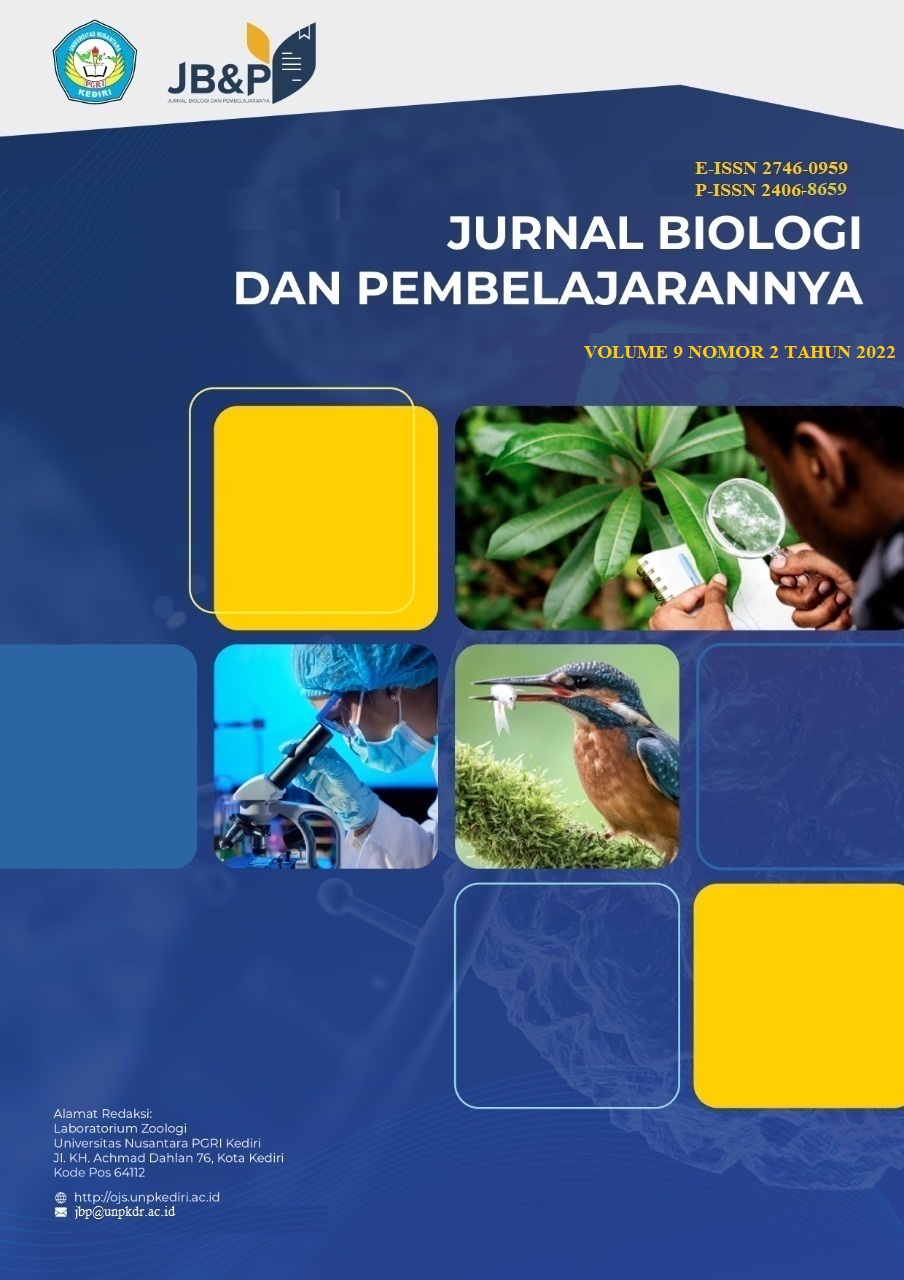Analisis Vegetasi Tumbuhan Herba Di Kawasan Hutan Krawak
DOI:
https://doi.org/10.29407/jbp.v9i2.18417Keywords:
Krawak forest, herbaceous plants, species density, important value index, diversity indexAbstract
Krawak forest is a protected forest that function to regulate water management, prevent fliooding and erosion, and maintain soil fertility. One of the plant habitus that contributes to the vegetation in the Krawak Forest is herbs. The existance of herbaceous plants in Krawak Forest is quite diverse, but so far there is no information about the species composition and diversity. This study aims to analyze the vegetation of herbaceous plants in the Krawak Forest by calculating species density, important value index, and diversity. The research was carried out on April 26, 2022.The type of research is quantitative descriptive, the sampling method is the quadratic method with a size of 1mx1m with 4 plots. Data collection techniques were carried out by recording the name and number of each species found in the plot, as well as the area covered by each species. Data analysis was carried out by calculating species density, dominance, and frequencys as the basis for calculating the important value index of each species. In addition, the Shannon-Wiener diversity index was also calculated to determine the level of diversity of herbaceous plants in the forest. The results of the study found 13 species of herbaceous plants belonging to 8 families, each family having a number of varied species as well as the number of individuals in each species.The highest species density was owned by Typhonium flagelliforme with a value of 38.36 and the lowest was Digitaria sanguinalis, Commelina benghalensis, and Verbesina alternifolia with the same value of 1.37. The highest important value index was Chromolaena odorata with a value of 54.60 and the lowest was Digitaria sanguinalis and Verbesina alternifolia with a value of 6.91. The diversity index obtained a value of 2.14 where this value indicates the level of forest diversity in Krawak forest is in the medium category.
References
Ali, H., Naemah, D., Yusanto, D., Program, N., & Kehutanan, S. (2022). Analisis Vegetasi Tumbuhan bawah di Sekitar Tegakan Aren (Arenga pinnata Merr) Vegetation Analysis of Understorey Plants Around the Aren (Arenga Pinnata Merr). Jurnal Sylva Scienteae, (5)1, 41–47.
Asmayannur, I., Chairul, & Syam, Z. (2012). AnalisisVegetasi Dasar di Bawah Tegakan Jati Emas (Tectona grandis L.) dan Jati Putih (Gmelina arborea Roxb.) di Kampus Universitas Andalas. Jurnal Biologi Universitas Andalas, (1)2, 172–177.
Destaranti, N., Sulistyani, S., & Yani, E. (2017). Struktur dan Vegetasi Tumbuhan Bawah Pada Tegakan Pinus di RPH Kalirajut dan RPH Baturraden Banyumas. Scripta Biologica, (4)3, 155–160. https://doi.org/10.20884/1.sb.2017.4.3.407
Haryadi, N. (2017). Struktur dan Komposisi Vegetasi pada Kawasan Lindung Air Terjun Telaga Kamoleh Kabupaten Gunung Mas. Ziraa’ah (42)2, 137–149.
Hidayat, M. (2017). Analisis Vegetasi dan Keanekaragaman Tumbuhan di Kawasan Manifestasi Geotermal IE Suum Kecamatan Mesjid Raya Kabupaten Aceh Besar. Jurnal Biotik, (5)2, 114–124.
Iqbal, M., Laratu, N., Pitopang, R., Suleman, S. M., Biologi, J., Matematika, F., Pengetahuan, I., Universitas, A., Kampus, T., Tadulako, B., Palu, T., Tengah, S., Jurusan, ), Mipa, P., Biologi, P., Keguruan, F., Pendidikan, I., & Tadulakokampus, U. (2014). Keanekaragaman Jenis Tumbuhan Herba Pada Dua Tipe Hutan Di Desa Bobo Kawasan Taman Nasional Lore Lindu Sulawesi Tengah. Jurnal Biocelebes, (8)2(2), 13–25.
Ismaini, L. (2015). Analisis komposisi dan keanekaragaman tumbuhan di Gunung Dempo, Sumatera Selatan. Pros Sem Nas Masy Biodiv Indon, (1)6, 1397–1402. https://doi.org/10.13057/psnmbi/m010623
Itawarnemi, H., Rasnovi, S., & Zumaidar. (2021). Vegetation analysis and plant diversity in Pinus Jantho Forest (PJF) nature reserve, Aceh Besar. Jurnal Natural, (21)1(1), 23–28. https://doi.org/10.24815/jn.v21i1.18417
Mariana, & Wardani Warso, F. (2016). Analisis Komposisi Dan Struktur Vegetasi Untuk Menentukan Indeks Keanekaragaman di Kawasan Hutan Kota Pekanbaru. Jurnal Pendidikan Biologi, (3)2, 90–96.
Martono, D. S. (2012). Analisis vegetasi dan asosiasi antara jenis-jenis pohon utama penyusun hutan tropis dataran rendah di Taman Nasional Gunung Rinjani Nusa Tenggara Barat. Agri-Tek , (13)2, 18–27.
Oktaviani, S. I., Hanum, L., & Negara, Z. P. (2017). Analisis Vegetasi di Kawasan Terbuka Hijau Industri Gasing. Jurnal Penelitian Sains, (19)3, 124–131.
Rahayu, E. M., Syarifuddin, A., & Galus, I. (2020). Analisis Vegetasi Di Kawasan Pulau Menjangan Taman Nasional Bali Barat (TNBB). Journal of Forestry Research, (3)2, 79–89.
Rizky, P., Manurung, T. F., & Wulandari, R. S. (2018). Permudaan Alam Jenis Meranti (Shorea spp.)Di Hutan Adat Pengajiddesa Sahan Kabupaten Bengkayang. Jurnal Hutan Lestari, (6)4, 979–987.
Saharjo, B. H., & Gago, C. (2011). Suksesi Alami Paska Kebakaran pada Hutan Sekunder di Desa Fatuquero, Kecamatan Railaco, Kabupaten Ermera-Timor Leste. Jurnal Sivikultur Tropika, (2)1, 40–45.
Supeksa, K., Putu Ella Deviana, N., Luh Gede Krisna Dewi, N., Made Ratmini, N., & Karolina, Y. (n.d.). Analisis Vegetasi dengan Metode Kuadrat pada plot yang dibuat dengan Bentuk Lingkaran Di Kebun Raya Eka Karya Bali. http://supeksa.wordpress.com
Ufiza, S., Salmiati, & Ramadhan, H. (2018). Analisis Vegetasi Tumbuhan Dengan Metode Kuadrat pada Habitus Herba di Kawasan Pegunungan Deudappulo Nasi Aceh Besar. Prosiding Seminar Nasional Biotik 2018.
Downloads
Published
Issue
Section
License
Authors who publish with this journal agree to the following terms:
- Copyright on any article is retained by the author(s).
- The author grants the journal, right of first publication with the work simultaneously licensed under a Creative Commons Attribution License that allows others to share the work with an acknowledgment of the work’s authorship and initial publication in this journal.
- Authors are able to enter into separate, additional contractual arrangements for the non-exclusive distribution of the journal’s published version of the work (e.g., post it to an institutional repository or publish it in a book), with an acknowledgment of its initial publication in this journal.
- Authors are permitted and encouraged to post their work online (e.g., in institutional repositories or on their website) prior to and during the submission process, as it can lead to productive exchanges, as well as earlier and greater citation of published work.
- The article and any associated published material is distributed under the Creative Commons Attribution-ShareAlike 4.0 International License













